[Note: this was originally intended for the latest edition of The Accretionary Wedge, now up at Clastic Detritus, which asked the geoblogosphere to look to the geological future. Sadly, it took much longer than I thought it would, and is therefore a bit late – but what’s a few days to a geologist?]
It’s fairly common knowledge that the Earth’s magnetic field periodically reverses its polarity. At the moment, magnetic field lines run from the south pole to the north pole, and point up in the southern hemisphere and down in the northern hemisphere, as in the figure on the left below. But at many points in the past, the field lines (and compasses, if they’d been invented) pointed south, and, as the figure on the right below shows, were directed upwards in the northern hemisphere and downwards in the southern hemisphere.
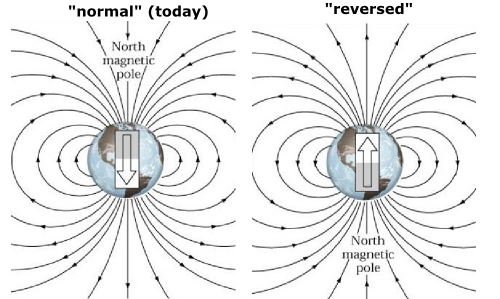
Rocks record the direction of the ambient magnetic field as they form, allowing us to reconstruct the history of these reversals. In the next figure, periods when the field is “normal” (the same as the present day) are in black, and periods when it is in the opposite, “reversed” polarity are in white. The field last flipped over about 780,000 years ago (0.78 million years); previous reversals occurred about 0.99, 1.07, 1.19, 1.2, 1.77 and 1.95 miilion years ago.

The last couple of million years worth’ of reversals. Each polarity interval, or ‘chron’, is named after either a famous palaeomagician (Brunhes, Matayama) or the location where it was first identified (Olduvai).
You can’t help but notice that the typical period between the reversals in the last couple of million years is a lot less than 780,000 years, which is why you might hear talk about us being ‘overdue’ a reversal. Is this true? When can we next expect the field to reverse? And should we care if it does?
The question of whether we should be expecting a reversal is most easily addressed by taking a longer view. The symmetric pattern of magnetic anomalies either side of mid-ocean ridges, give us a continuous record of magnetic reversals stretching back almost 200 million years. This shows that the time between reversals is not constant, varying from a few hundred thousand years to many millions of years, as it did in the Late Cretaceous normal “superchron” (the big black block between about 85 and 125 million years ago) where the field retained the same polarity for around 40 million years.

This longer view suggests that trying to predict the geomagnetic future from the ‘periodicity’ of past reversals is a risky enterprise, to say the least. But that’s not the end of the story; by looking at the recorded behaviour of the magnetic field prior to previous flips, it might be possible to identify precursors that may herald the next one. We palaeomagicians are particularly interested in how the strength of the Earth’s magnetic field varies during reversals, because geodynamo theory suggests that reversals are probably more likely to happen when fluctuations in outer core convection weaken and destabilise the dipole. This prediction is particularly relevant in light of the fact that the strength of the Earth’s magnetic field has been steadily decreasing, at a rate of about 5% a century, since we first started directly measuring it in the mid 1800s. Is this a prelude to a reversal? Without a better idea of how the geodynamo behaves over geological time, there’s no way of knowing.
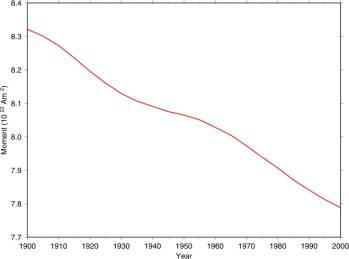
Source: BGS
Fortunately, rocks can preserve information about the palaeointensity (literally, ancient intensity) of the Earth’s magnetic field. Effectively, the stronger the magnetizing field, the stronger the rock’s magnetisation will be. If you measure the magnetisation acquired by your rock samples in artificial magnetic fields of known value, you can use this experimentally determined relationship to infer the strength of the geomagnetic field required to impart the original remanent magnetization.

In practice, reliable measurements of absolute palaeointensity can be quite tricky*. However, although absolute values would be nice, we’re actually most interested in relative changes in the strength of the field over time – and if you can find some nice continuous sedimentary sections with constant mineralogy, you can be reasonably sure that changes in the intensity of the magnetisation as you move up- or down-section are mainly due to changes in magnetic field strength at the time of deposition (in other words, if the characteristics of the recording medium stay constant, then variations in the record must be due to changes in the input signal). Increasing numbers of relative paleointensity records, mainly from measurements of marine sediment cores, have been published in recent years. If you’re clever, like Jean-Pierre Valet et al. were in their 2005 Nature paper, you can stitch and stack** the most reliable of these records together, to produce a composite curve of the last 2 million years of relative variations in geomagnetic field strength.
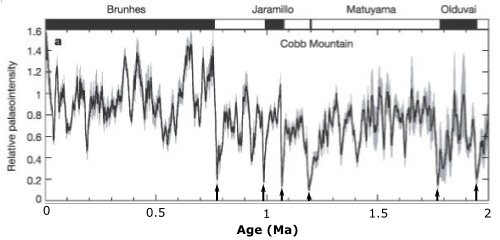
There’s no other word for it – these data are beautiful. Every switch in polarity occurs when the field is at its weakest – the palaeointensities are lower during reversals than at any other point in this record. Rather intriguingly, slightly less extreme dips in the field intensity appear to be associated with what are called excursions – periods where changes in the direction of the recorded magnetization show that the magnetic poles have wandered quite a long way from the geographic poles, but without the field reversing. So, just as geodynamo theory predicts, a weakening of the magnetic field seems to be associated with less dipole-like behaviour, and reversals. It’s interesting to note that the field seems to have been stronger, on average, since the last reversal, which might explain why this current polarity interval has lasted longer than the preceding ones.
The other interesting thing about this record is that the field has behaved in quite a consistent way during every reversal. In the figure below, Valet et al. plot the changes in field intensity across each individual change in polarity atop one another, with time decreasing from right to left. In each case, the reversal is preceded by at least 20,000-40,000 years of fairly continuous decay in field strength to about the same (very low) value, with a much more rapid recovery in field strength following the transition. In this context, a couple of centuries’ worth of field decay is not particularly significant, especially since the present field strength (about 8 on the scale in this figure) is still a lot higher than the value reached during all of these reversals (<2).
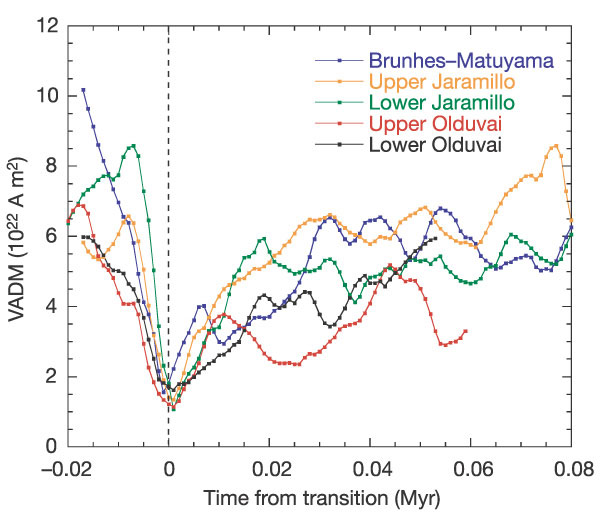
To really place recent field behaviour in context, we really need a better idea of what was going on geomagnetically prior to the instrumental record. As it turns out, archaeological sites are a very good source of absolute palaeointensity data: – human artefacts like hearths, forges, and kiln-baked pottery are pretty good magnetic recorders, with easy to understand behaviour. In a recent paper, Knudsen et al. use the wealth of palaeointensity measurements from the last 12,000 years or so to produce a best-fit model of dipole strength for the Holocene (the grey shaded region is the estimated error – and note that the time axis here runs the other way to all the other figures…).
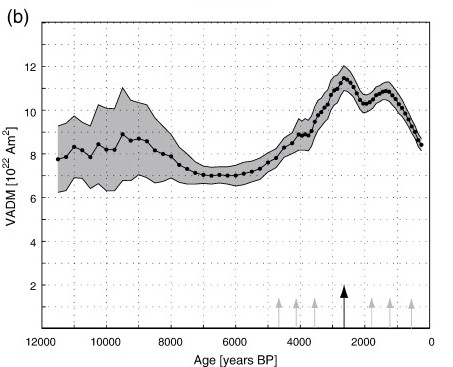
This shows that for most of the last 12,000 years, the field strength was actually lower than it is today; it increased between about 4,500 and 2,500 years ago, and after this peak- which is high even when you look over the last 2 million years – it has been decreasing again for most of the last 2,000 years. If you compare the duration and magnitude of the recent decrease (the red box in the figure below) to the field behaviour for past reversals, it doesn’t look like we have to worry about the field reversing for a while – it looks like it needs to continue weakening for a few thousand more years, and reach a much lower strength, before a reversal is going to happen.
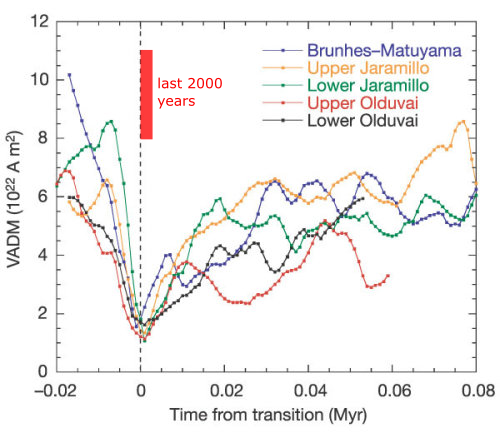
Of course, another thing you should get from the Valet et al. paper is that a full reversal sequence is not an instantaneous event; our compasses will not point north today and south tomorrow. Instead, the geomagnetic field will weaken, and the magnetic poles will start to wander to lower latitudes, and possibly multiply, over a period of hundreds and thousands of years. It looks dramatic from the perspective of Deep Time, but during a reversal the changes over a human lifetime will probably be little different from the secular variation we see today. No extinction event has ever been linked to a magnetic field reversal, and I think that we might just cope with the next one too – whenever it might occur.
*The magnetic behaviour of a sample in response to fields applied over timescales of maybe a few minutes in the lab might be very different to its response over the thousands or tens of thousand of years that it might take to be magnetised in the wild. Problems with complex magnetic mineralogy, and overprints, and possible thermal alteration during the experiments, are also rife.
**Stacking is just an averaging technique, and helps to remove noise and variations in the field local to the region each core was taken from, producing a smoother global signal.
Jean-Pierre Valet, Laure Meynadier, Yohan Guyodo (2005). Geomagnetic dipole strength and reversal rate over the past two million years Nature, 435 (7043), 802-805 DOI: 10.1038/nature03674
M KNUDSEN, P RIISAGER, F DONADINI, I SNOWBALL, R MUSCHELER, K KORHONEN, L PESONEN (2008). Variations in the geomagnetic dipole moment during the Holocene and the past 50 kyr Earth and Planetary Science Letters, 272 (1-2), 319-329 DOI: 10.1016/j.epsl.2008.04.048



Comments (42)
Links (1)-
Pingback: Earth’s magnetic field: still not reversing | Highly Allochthonous